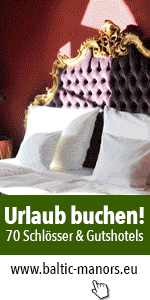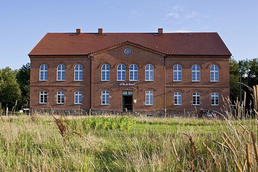Manor House Hessenburg
The present day Hessenburg is regarded as one of the oldest settlement areas in West Pomerania; a witness to its early creation is the unusually tall motte dating from the 13th century in the north-east of the estate complex. A millstone was excavated whilst the ring ditch was being restored by the State Office for Environmental Protection and Conservation restoration in 2002.
Good land and the preferred location behind the Bodden suggest a continual settlement. Schlichtemühl was documented in writing and precisely recorded in the Swedish Register from 1692 to 1698; an historical summary which closes the gaps in time is also in this.
Lorenz Gustv Vollrath Hesse, one of the ancestors of Mrs. Ute Göseke, maiden name von Hesse, was the pledge lord of the noble fiefdom estate of Redebas in West Pomerania. His brother, Jacob Philipp Johann Hesse, was a Royal Swedish Officer and being raised to the nobility followed on 3 March 1785 in Vienna. The Hesse family acquired the feudal Schlichtemühl estate in 1786 from the bankrupt estate of the owner von Gentzkow. The ca. 760 ha. feudal estate was under the continuous ownership of von Hesse up until 1945. The family asked King Friedrich Wilhelm IV. in Berlin for permission to rename the “Schlichtemühl” estate to “Hessenburg”. This was approved on 27 July 1840 by the highest cabinet level order; the von Hesse family was from then on allowed to bear the Prussian extended name of “von Hesse-Hessenburg”, tied to ownership of the entailed estate Hessenburg.
They have buried their dead on the motte since the 19th century which had been designed as an honourable graveyard area with a bridge, gate, urn burials and a gravestone wall. This was all laid waste by soldiers at the end of World War II. In 1935, due to a government decision, ca 150 ha. had to be sold to incomers, who returned to the Empire from West Prussia. Mrs. Göseke, maiden name von Hesse, is the last of her line. She lives in Hamburg today and takes an active interest in the rebuilding of her parent’s house.
The Kranich Museum has been at home in the largely renovated manor house since 2012. Numerous international artists present their ideas and interpretations here on the subject of »Crane«. You can however also find insights into the history of the honourable estate in the rooms.
The manor house in Hessenburg is ideally suited for weddings. The registry office is in the building and the Restaurant and Café »Alte Schmiede« is only a few steps away. The six apartments of the Kranich Hotel were completed in 2015. There are two further apartments in the former coach house.
The play and learn trail for children »I am a crane« was made in the summer of 2014: The first stop is in sight of the old smithy is a giant egg made of wood, broken because the crane chick Grus Grus has just hatched from it. Grus Grus tells the children on boards how long he needed to do that and – in the following stops – how it continues with becoming a grown up. At the far back of the park the children can dance the crane dance on tree discs, balance high up on a climbing frame with a natural finish and lastly learn to »fly« on a long thick rope. The accompanying texts from the life of the crane are written so that children can easily understand them.
The manor house was awarded the »Monument Sign of the State of Mecklenburg-West Pomerania« on 15 October 2014.


